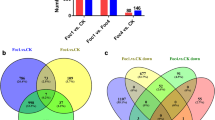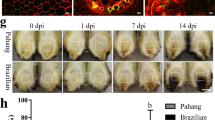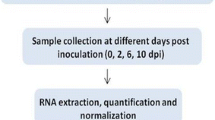Abstract
Fusarium wilt caused by the fungus Fusarium oxysporum f. sp. cubens (Foc) is the most serious disease that attacks banana plants. Salicylic acid (SA) can play a key role in plant–microbe interactions. Our study is the first to examine the role of SA in conferring resistance to Foc TR4 in banana (Musa acuminata L. AAA group, cv. Cavendish), which is the greatest commercial importance cultivar in Musa. We used quantitative real-time reverse polymerase chain reaction (qRT-PCR) to analyze the expression profiles of 45 genes related to SA biosynthesis and downstream signaling pathways in a susceptible banana cultivar (cv. Cavendish) and a resistant banana cultivar (cv. Nongke No. 1) inoculated with Foc TR4. The expression of genes involved in SA biosynthesis and downstream signaling pathways was suppressed in a susceptible cultivar and activated in a resistant cultivar. The SA levels in each treatment arm were measured using high-performance liquid chromatography. SA levels were decreased in the susceptible cultivar and increased in the resistant cultivar. Finally, we examined the contribution of exogenous SA to Foc TR4 resistance in susceptible banana plants. The expression of genes involved in SA biosynthesis and signal transduction pathways as well as SA levels were significantly increased. The results suggest that one reason for banana susceptibility to Foc TR4 is that expression of genes involved in SA biosynthesis and SA levels are suppressed and that the induced resistance observed in banana against Foc TR4 might be a case of salicylic acid-dependent systemic acquired resistance.











Similar content being viewed by others
References
Achnine L, Blancaflor EB, Rasmussen S et al (2004) Colocalization of L-phenylalanine ammonia-lyase and cinnamate 4-hydroxylase for metabolic channeling in phenylpropanoid biosynthesis. Plant Cell 16(11):3098–3109
An C, Mou Z (2011) Salicylic acid and its function in plant immunity. J Integr Plant Biol 53:412–428
Arnon DI, Hoagland DR (1939) A comparison of water culture and soil as media for crop production. Science 89:512–514
Aurore G, Parfait B, Fahrasmane L (2009) Bananas, raw materials for making processed food products. Trends Food Sci Technol 20(2):78–91
Bai TT, Xie WB, Zhou PP et al (2013) Transcriptome and expression profile analysis of highly resistant and susceptible banana roots challenged with Fusarium oxysporum f. sp. cubense tropical race 4. PLoS One 8(9):e73945
Boatwright JL, Pajerowska-Mukhtar K (2013) Salicylic acid: an old hormone up to new tricks. Mol Plant Pathol 14(6):623–634
Chen Z, Zheng Z, Huang J, Lai Z, Fan B (2009) Biosynthesis of salicylic acid in plants. Plant Signal Behav 4(6):493–496
De Ascensao AR, Dubery IA (2000) Panama disease: cell wall reinforcement in banana roots in response to elicitors from Fusarium oxysporum f. sp. cubense race four. Phytopathology 90(10):1173 1180
Dixon RA, Achnine L, Kota P, et al (2002) The phenylpropanoid pathway and plant defence - a genomics perspective. Mol Plant Pathol 3:371–390
Douglas CJ (1996) Phenylpropanoid metabolism and lignin biosynthesis: from weeds to trees. Trends Plant Sci 1(6):171–178
Durrant WE, Dong X (2004) Systemic acquired resistance. Annu Rev Phytopathol 42:185–209
Edgar CI, McGrath KC, Dombrecht B, et al (2006) Salicylic acid mediates resistance to the vascular wilt pathogen Fusarium oxysporum in the model host Arabidopsis thaliana. Aust Plant Pathol 35:581–591
Endah R, Beyene G, Kiggundu A, van den Berg N, Schlüter U, Kunert K, Chikwamba R (2008) Elicitor and Fusarium-induced expression of NPR1-like genes in banana. Plant Physiol Biochem 46(11):1007–1014
Ferrer JL, Jez JM, Bowman ME et al (1999) Structure of chalcone synthase and the molecular basis of plant polyketide biosynthesis. Nat Struct Mol Biol 6(8):775–784
Fortunato AA, Rodrigues FA, Baroni JCP et al (2012) Silicon suppresses Fusarium wilt development in banana plants. J Phytopathol 160(11–12):674–679
Ghag SB, Shekhawat UKS, Ganapathi TR (2012) Petunia floral defensins with unique prodomains as novel candidates for development of Fusarium wilt resistance in transgenic banana plants. PLoS One 7(6):e39557
Glazebrook J (2005) Contrasting mechanisms of defense against biotrophic and necrotrophic pathogens. Annu Rev Phytopathol 43:205–227
Grimm D (2008) Plant genomics. A bunch of trouble. Science 322:1046–1047
Hennig J, Malamy J, Grynkiewicz G, Indulski J, Klessig DF (1993) Interconversion of the salicylic acid signal and its glucoside in tobacco. Plant J 4:593–600
Hoffmann L, Besseau S, Geoffroy P et al (2004) Silencing of hydroxycinnamoyl-coenzyme A shikimate/quinate hydroxycinnamoyltransferase affects phenylpropanoid biosynthesis. Plant Cell 16:1446–1465
Huang YH, Wang RC, Li CH, Zuo CW, Wei YR, Zhang L, Yi GJ (2012) Control of Fusarium wilt in banana with Chinese leek. Eur J Plant Pathol 134(1):87–95
Hwang SC, Ko WH (2004) Cavendish banana cultivars resistant to Fusarium wilt acquired through somaclonal variation in Taiwan. Plant Dis 88:580–588
Kochs G, Grisebach H (1989) Phytoalexin synthesis in soybean: purification and reconstitution of cytochrome P450 3,9-dihydroxypterocarpan 6a-hydroxylase and separation from cytochrome P450 cinnamate 4-hydroxylase. Arch Biochem Biophys 273(2):543–553
Koenig RL, Ploetz RC, Kistler HC (1997) Fusarium oxysporum f. sp. cubense consists of a small number of divergent and globally distributed clonal lineages. Phytopathology 87(9):915–923
Kostyn K, Czemplik M, Kulma A et al (2012) Genes of phenylpropanoid pathway are activated in early response to Fusarium attack in flax plants. Plant Sci 190:103–115
Lebel E, Heifetz P, Thorne L, Uknes S, Ryals J, Ward E (1998) Functional analysis of regulatory sequences controlling PR-1 gene expression in Arabidopsis. Plant J 16:223–233
Li CY, Deng GM, Yang J, Viljoen A, Jin Y, Kuang RB et al (2012) Transcriptome profiling of resistant and susceptible Cavendish banana roots following inoculation with Fusarium oxysporum f. sp. cubense tropical race 4. BMC Genomics 13(1):374
Li C, Shao J, Wang Y et al (2013) Analysis of banana transcriptome and global gene expression profiles in banana roots in response to infection by race 1 and tropical race 4 of Fusarium oxysporum f. sp. cubense. BMC Genomics 14(1):851
Livak KJ, Schmittgen TD (2001) Analysis of relative gene expression data using real-time quantitative PCR and the 2−ΔΔCT method. Methods 25(4):402–408
Lü G, Guo S, Zhang H, Geng L, Song F, Fei Z, Xu Y (2011) Transcriptional profiling of watermelon during its incompatible interaction with Fusarium oxysporum f. sp. niveum. Eur J Plant Pathol 131(4):585–601
Mandal S, Mallick N, Mitra A (2009) Salicylic acid-induced resistance to Fusarium oxysporum f. Sp. Lycopersici in tomato. Plant Physiol Biochem 47(7):642–649
Patel M, Kothari IL, Mohan JS (2004) Plant defense induced in in vitro propagated banana (Musa Paradisiaea) plantlets by fusarium derived elicitors. Indian J ExP Biol 42(7):728–731
Paul JY, Becker DK, Dickman MB, Harding RM, Khanna HK, Dale JL (2011) Apoptosis–related genes confer resistance to Fusarium wilt in transgenic ‘Lady Finger’ bananas. Plant Biotechnol J 9(9):1141–1148
Pérez-Vicente L (2004) Fusarium wilt (Panama disease) of bananas: an updating review of the current knowledge on the disease and its causal agent. Reunión Int Acrobat 16:1–15
Pieterse CM, Van Loon LC (2004) NPR1: the spider in the web of induced resistance signaling pathways. Curr Opin Plant Biol 7(4):456–464
Pieterse MJ, Dieuwertje VD, Christos Z, et al (2012) Hormonal modulation of plant immunity. Annu Rev Cell Dev Biol 28:1–33
Ploetz RC (2000) Panama disease: a classic and destructive disease of banana. Plant Health Prog 10:1–7
Ploetz RC (2006) Fusarium wilt of banana is caused by several pathogens referred to as Fusarium oxysporum f. sp. cubense. J Phytopathol 96:653–656
Ryals JA, Neuenschwander UH, Willits MG, Molina A, Steiner HY, Hunt MD (1996) Systemic acquired resistance. Plant Cell 8(10):1809
Sarwar N, Ch Z, Hayat M, et al (2010) Seed treatments induced systemic resistance in chickpea against fusarium wilt in wilt sick field. Pak J Bot 42(5):3323–3326
Van den Berg N, Berger DK, Hein I, Birch PRJ, Wingfield MJ, Viljoen A (2007) Tolerance in banana to Fusarium wilt is associated with early up-regulation of cell wall-strengthening genes in the roots. Mol Plant Pathol 8:333–341
Visser M, Gordon T, Fourie G, Viljoen A (2010) Characterisation of South African isolates of Fusarium oxysporum f. sp. cubense from Cavendish bananas. S Afr J Sci 106(3–4):01–06
Vlot AC, Dempsey DMA, Klessig DF (2009) Salicylic acid, a multifaceted hormone to combat disease. Annu Rev Phytopathol 47:177–206
Vogt T (2010) Phenylpropanoid biosynthesis. Mol Plant 3(1):2–20
Wan CY, Wilkins TA (1994) A modified hot borate method significantly enhances the yield of high-quality RNA from cotton (Gossypium hirsutum L.). Anal Biochem 223:7–12
Wang Zhuo, Zhang Jian Bin, Jia Cai Hong et al. (2012) De Novo characterization of the banana root transcriptome and analysis of gene expression under Fusarium oxysporum f. sp. cubense tropical race 4 infection. BMC Genomics 13: 650: 1–9
Wang X, Sager R, Cui W et al (2013) Salicylic acid regulates plasmodesmata closure during innate immune responses in Arabidopsis. Plant Cell 25(6):2315–2329
Whetten R, Sederoff R (1995) Lignin biosynthesis. Plant Cell 7(7):1001–1013
Wildermuth MC, Dewdney J, Wu G et al (2001) Isochorismate synthase is required to synthesize salicylic acid for plant defence. Nature 414(6863):562–565
Wu Y, Yi G, Peng X, Huang B, Liu E, Zhang J (2013) Systemic acquired resistance in Cavendish banana induced by infection with an incompatible strain of Fusarium oxysporum f. sp. cubense. J Plant Physiol 170:1039–1046
Xu CX, Xiao J, He JG, Hu GB, Chen HB (2011) The effect of ethyl-methane sulphomate (EMS) and sodium azide on plant regeneration capacity of an embryogenic cell suspension of ‘Yueyoukang 1’ (Musa, AAA), a banana cultivar resistant to Fusarium wilt. Acta Hortic (ISHS) 897:301–302
Yin XM, Xu BY, Zheng W, Wang Z et al (2011) Characterization of early events in banana roots infected with green fluorescent protein-tagged Fusarium oxysporum f. sp. cubense. Acta Hortic (ISHS) 897:371–376
Zabala G, Zou J, Tuteja J, et al (2006) Transcriptome changes in the phenylpropanoid pathway of Glycine max in response to Pseudomonas syringae infection. BMC Plant Biol 6(1):26
Zhang H, Mallik A, Zeng RS (2013) Control of Panama disease of banana by rotating and intercropping with Chinese chive (Allium tuberosum Rottler): role of plant volatiles. J Chem Ecol 39:243–252
Zhou Xingang, Wu Fengzhi (2009) Differentially expressed transcripts from cucumber (Cucumis sativus L.) root upon inoculation with Fusarium oxysporum f. sp. cucumerinum Owen. Physiological and Molecular Plant Pathol 74:142e150
Acknowledgments
This work was supported by earmarked funds for the Modern Agro-industry Technology Research System of China (CARS-32), the National Natural Science Foundation of China (NNSFC) (31071788), National Nonprofit Institute Research Grant of CATAS (1630052014009), and the Major Technology Project of Hainan (ZDZX2013023-1).
Author information
Authors and Affiliations
Corresponding authors
Additional information
Zhuo Wang and Caihong Jia contributed equally to this work.
Electronic supplementary material
Below is the link to the electronic supplementary material.
ESM 1
(DOC 1,912 kb)
Rights and permissions
About this article
Cite this article
Wang, Z., Jia, C., Li, J. et al. Activation of salicylic acid metabolism and signal transduction can enhance resistance to Fusarium wilt in banana (Musa acuminata L. AAA group, cv. Cavendish). Funct Integr Genomics 15, 47–62 (2015). https://doi.org/10.1007/s10142-014-0402-3
Received:
Revised:
Accepted:
Published:
Issue Date:
DOI: https://doi.org/10.1007/s10142-014-0402-3




